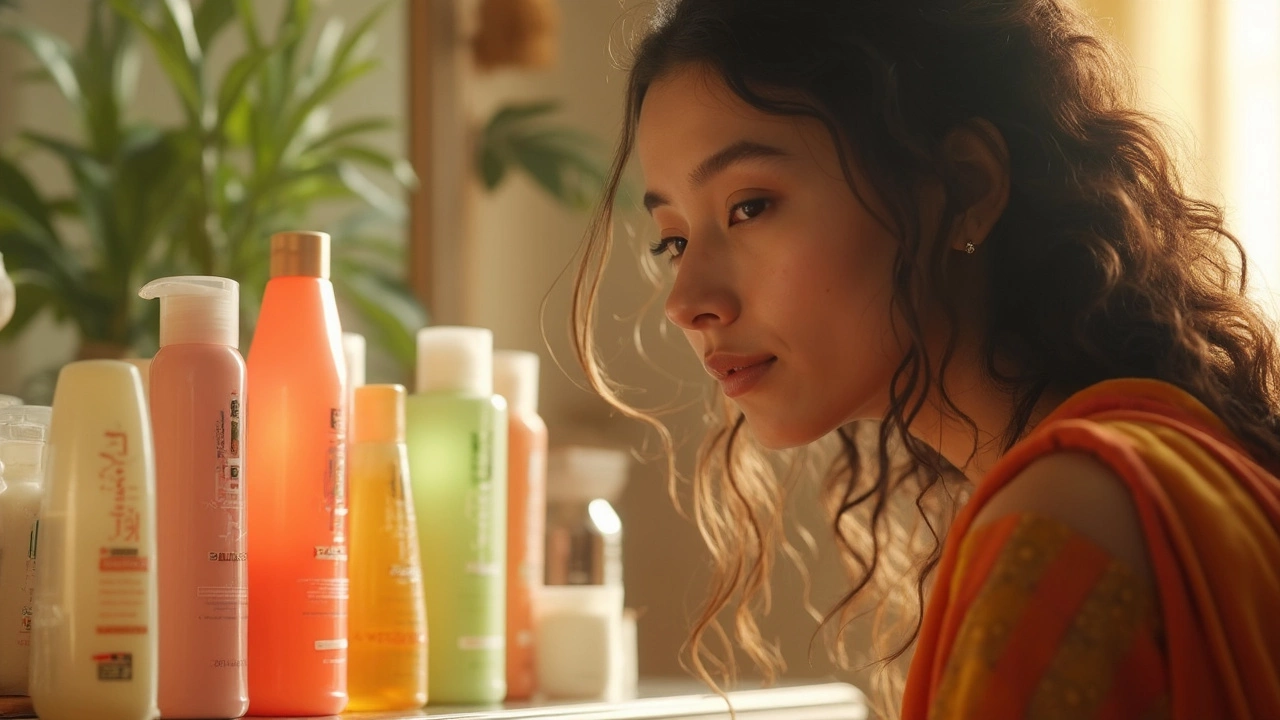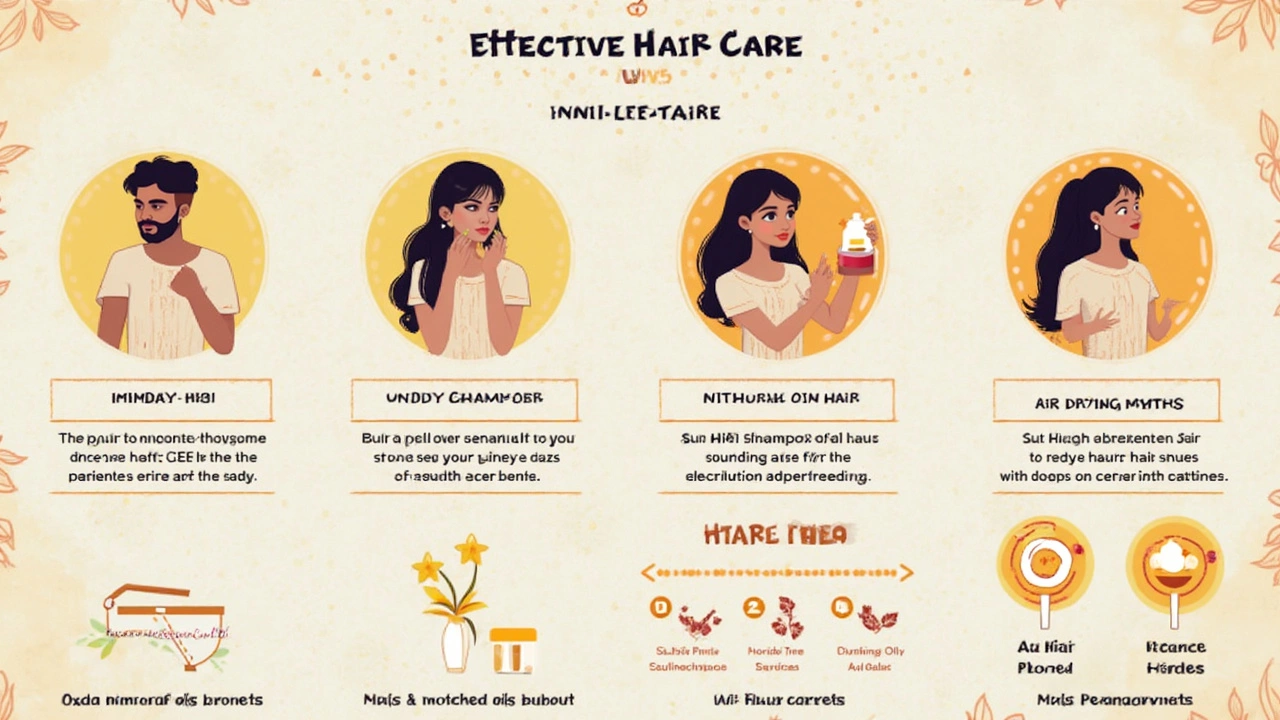
If you've spent hours scrolling through endless hair care ads and influencer posts, you're not alone. It feels like every bottle promises perfect hair—shiny, thicker, zero frizz—yet most of them barely move the needle. So what actually helps?
The truth is, your hair needs only a few simple things to thrive. It's not about using twenty products or picking the most expensive brand. Basics like using the right shampoo and conditioner for your hair type still beat fancy-sounding serums most days of the week. And while growth oils and masks make big claims, only some live up to the hype—scalp health is a game-changer, but not everything that tingles or smells like menthol is helping.
Ever notice that people with great hair often have a routine that looks... boring? That's because consistency matters way more than chasing the latest trend. Daily choices—gentle washing, skipping harsh heat, using a silk pillowcase—can have more impact than any single miracle bottle.
- Sorting the Hype from Reality
- Daily Basics: Shampoo, Conditioner, and Beyond
- Targeted Fixes for Hair Goals
- Simple Habits That Make a Difference
Sorting the Hype from Reality
Hair care shelves are packed with products claiming to change your life. Most of these are just good marketing. Let's break down what really works for hair and what’s just clever packaging.
First off, “miracle” ingredients like biotin and collagen get slapped on labels everywhere. But if your diet is already fine, adding biotin shampoo won’t do much. Biotin only helps if you’re actually low on it, and most people aren’t. Don’t fall for shampoos promising magical hair growth; shampoo doesn’t stay on your scalp long enough to make a real difference anyway. Save your money for better basics.
“Sulfate-free” has become a buzzword. Yes, sulfates can be drying, especially if you have color-treated or curly hair. But for people with oily hair, a gentle sulfate can actually help. No ingredient is good or bad for everyone – it’s about what works for your hair type.
Let’s look at some facts behind the promises:
| Claim | Reality |
|---|---|
| Keratin Shampoos repair hair | Keratin in shampoo coats hair for smoothness, but your hair can’t "heal" dead ends |
| Oils like argan or coconut fix split ends | Oils add shine and reduce frizz but only scissors can remove split ends |
| “Hair vitamins” boost hair growth | Unless you’re truly deficient in something, extra vitamins won’t thicken hair |
On the other hand, certain things actually work, boring as they sound. Using a good conditioner can seriously help with dryness and tangles. Scalp care is trending now for a reason—healthy roots are the secret to healthy hair. Gentle brushing, skipping harsh treatments, and basic protection from sun and heat are worth more than any “overnight miracle.”
So next time you see a bottle promising instant transformation, give it a second look. The stuff that works tends to sound pretty practical. Save the big bucks for things that really change the game—like a top-notch hair care routine and products actually matched to your needs.
Daily Basics: Shampoo, Conditioner, and Beyond
Let’s get real—a solid hair routine often comes down to the basics. Choosing the right hair care staples like shampoo and conditioner does more for your hair than some fancy leave-in you saw on TikTok.
Start with shampoo. If your scalp gets oily, you’ll need something clarifying a couple of times a week, but not every day—stripping your hair leads to frizz and dullness. Look for shampoos with simple ingredients and skip anything loaded with sulfates if your hair is color-treated or dry. Fun fact: A 2022 consumer survey found that 67% of people noticed less breakage when using sulfate-free products.
After washing, a legit conditioner should always make the cut. Your conditioner’s main job isn’t a miracle—it's to untangle, soften, and protect. If you have fine hair, go for lightweight or volumizing versions; thick or curly hair craves the heavier, creamy types. Don’t dump a ton straight on the roots—focus from mid-length to ends to avoid greasy scalp.
- If your hair’s super dry, swap a regular conditioner for a leave-in on busy days. These make detangling way easier and help with frizz later on.
- Deep conditioners or “masks”? Once a week is great unless your hair is oily—then maybe less. Masks aren’t magic but can help if you use heat or bleach often.
Want to go beyond basics? Try scalp scrubs once a week to clear product buildup, or use a lightweight oil after styling to lock in shine—but skip heavy oils if you have thin or flat hair.
Here’s a quick rundown to match your hair type with the right basics:
| Hair Type | Shampoo | Conditioner |
|---|---|---|
| Oily | Clarifying (2x/week) | Light, rinse-out |
| Dry | Sulfate-free, hydrating | Deep or leave-in |
| Curly/Coily | Creamy, moisturizing | Rich, heavy |
| Fine | Volumizing | Light, avoid roots |
Bottom line: Products need to actually fit your hair, not your best friend’s or your favorite celebrity’s. Consistency with the right stuff is worth more than buying the whole aisle.

Targeted Fixes for Hair Goals
No one wants to waste time or money on products that don’t do much. The trick? Choose hair products matched to what you want to fix—think frizz, breakage, volume, or growth. The science is clear: ingredients matter more than fancy labels or celebrity endorsements.
If your dream is thicker hair, look for shampoos and topicals with minoxidil. Yep, the same FDA-approved ingredient found in Rogaine actually works for both men and women. Biotin and caffeine sound promising, but studies don’t show dramatic results unless you’re already short on those nutrients. For brittle, damaged hair, protein-rich conditioners can temporarily patch weak spots, but don’t overdo it—too much protein makes hair stiff and more likely to snap.
When frizz is your enemy, smoothing treatments and leave-in conditioners with silicones (like dimethicone) or natural oils (argan, coconut) work by coating the hair shaft, locking out humidity. If volume is the goal, lightweight mousses and sprays with polymers lift hair without weighing it down. People with curls swear by sulfate-free shampoo to keep hair soft and bouncy since harsh detergents can strip away moisture.
- Deep conditioning masks: Once a week, these can restore shine to fried hair. Look for shea butter or keratin, not cheap fillers.
- Heat protectant sprays: If you use a blow dryer or flat iron, these sprays help prevent the damage that leads to breakage.
- Scalp serums: Lightweight treatments with niacinamide or rosemary oil can support hair growth by boosting scalp circulation.
Here’s a quick breakdown of key ingredients to keep on your radar:
| Common Hair Issue | Best Ingredient/Action |
|---|---|
| Hair loss/thinning | Minoxidil, scalp massage |
| Breakage | Keratin, light protein |
| Lack of shine | Argan oil, deep masks |
| Frizz/humidity | Silicones, anti-frizz serums |
| Scalp itch/dandruff | Salicylic acid, zinc pyrithione |
Ignore buzzwords like "detox" or "miracle" unless you see clinically proven ingredients. Real results come down to choosing the right hair care product for your problem and actually sticking with it for a few weeks. Instant changes are rare—consistency wins here.
Simple Habits That Make a Difference
You don’t need an army of hair care products to see real changes in your hair. A few everyday habits make a bigger difference than any miracle mask. Let’s get into what actually helps—backed by research, not just a TikTok trend.
First, shampoo less often. It sounds simple, but overwashing strips your natural oils, leaving you with hair that’s drier, frizzier, and more prone to breakage. Unless your scalp is super oily, washing two or three times a week is plenty for most people. Using a gentle hair care shampoo made for your hair type helps even more.
Next up: never skip conditioner. Conditioners help replace lost moisture and smooth the cuticle, which literally makes hair shinier and less tangled. If you color your hair, look for a conditioner labeled for color-treated hair to protect your investment.
And yes, ditching heat tools more often is a big deal. Did you know using a flat iron daily can double the risk of hair breakage? Air dry when you can, or use a blow dryer with a diffuser on the lowest setting.
Protecting your hair while you sleep is another spot where small changes pay off. Sleeping on a silk or satin pillowcase really does reduce friction—which adds up to less breakage and frizz. Switching from tight hair elastics to gentle scrunchies can also mean fewer split ends over time.
Here’s a quick look at some simple habits and their impact, based on real studies:
| Habit | Impact on Hair |
|---|---|
| Washing hair 2-3x per week | Reduces dryness by up to 30% |
| Using conditioner each wash | Cuts tangling and breakage rate |
| Air drying over heat styling | Lowers damage, increases shine |
| Silk/satin pillowcase | Less frizz and static, better moisture retention |
Finally, don’t overlook scalp care. Massaging your scalp for a few minutes daily increases blood flow, which can help boost hair growth if you’re hoping for more length or stronger strands.
Small, consistent changes really add up. Skipping the hype and sticking to these simple steps is still the fastest way to better hair—no endless shelves of hair care products needed.
 Hair Care
Hair Care